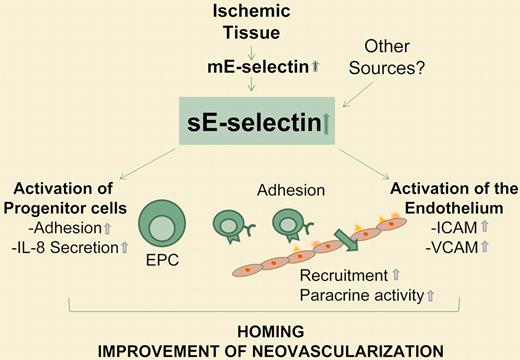The efficiency of cell therapy to augment recovery after ischemia may be limited by the rather low recruitment of cells to the target tissue. A new study by Oh and colleagues demonstrates that soluble E-selectin increases homing of progenitor cells by several mechanisms.
Cell therapy provides a novel and promising option for treatment of ischemic diseases. However, the homing of infused or injected cells is limited, with 2% to 10% of the infused cells being detectable in the target tissue. Strategies to improve homing and engraftment may provide an additional therapeutic benefit.1 Prestimulating infused cells with small molecules to activate the signaling pathways involved in homing and survival or overexpression of antiapoptotic proteins may be one option. Delivery of proteins or genes to the target tissue to enhance the attraction and recruitment of cells is an alternative (or additional) approach. Several cytokines have been shown to contribute to recruitment of infused cells, including the most prominent hypoxia-induced expression of SDF-1, which is responsible for attracting and retaining CXCR4+ stem/progenitor cells and pro-angiogenic bone marrow–derived cells.
Oh and colleagues have now identified another interesting ischemia-induced player, soluble E-selectin (sE-selectin), which stimulates the homing of progenitor cells.2 The authors' idea was based on their seminal finding that ischemia increases expression of the membrane form of E-selectin, mE-selectin, in is-chemic tissue and augments the concentration of shed circulating sE-selectin. The causal involvement of E-selectin was then confirmed by using E-selectin–deficient mice or by siRNA technology. Both approaches resulted in impaired cell homing and reduced recovery of perfusion after induction of ischemia, documenting the requirement of E-selectin. Interestingly, the injection of sE-selectin rescued the knock-out mouse phenotype, indicating that the soluble form is sufficient for recovery of blood flow after ischemia. sE-selectin exhibited at least 2 different functions: It activated endothelial cells to express the adhesion molecules VCAM and ICAM, which are well known to contribute to progenitor cell recruitment in ischemic models, and it directly increased angiogenesis.2 Moreover, sE-selectin promoted adhesion and migration of bone marrow–derived endothelial progenitor cells in vitro.
In accordance with these findings, another group recently reported that the overexpression of mE-selectin increases the recovery of neovascularization after hind-limb ische-mia when used in combination with cell therapy.3 In addition, IL-8 synthesis was augmented in endothelial progenitor cells after sE-selectin treatment. Because IL-8 promotes homing of CD34+ to ischemic tissue and stimulates angiogenesis, it may further enhance cell incorporation and neovascularization.
In summary, sE-selectin induced multiple effector mechanisms both in the target tissue and in the infused cells themselves, which together may contribute to the profound increase in progenitor cell recruitment (see figure). Some of the mechanisms, such as the expression of ICAM, were seen even in the absence of acute ischemia. This might be of therapeutic benefit when cell therapy is applied to nonischemic patients, in whom alternate homing signals such as VEGF and SDF-1 are severely impaired.4 However, it remains to be established whether the injection of sE-selectin alone is sufficient to induce a significant recruitment in the absence of injury.
Proposed mechanism of soluble E-selectin-mediated improvement of neovascularization. sE-selectin indicates soluble E-selectin; EPC, endothelial progenitor cells.
Proposed mechanism of soluble E-selectin-mediated improvement of neovascularization. sE-selectin indicates soluble E-selectin; EPC, endothelial progenitor cells.
Conflict-of-interest disclosure: The author declares no competing financial interests. ■


This feature is available to Subscribers Only
Sign In or Create an Account Close Modal